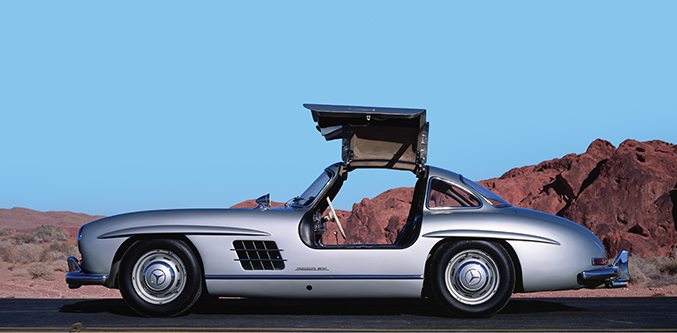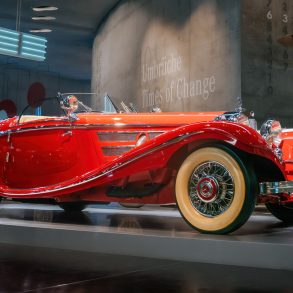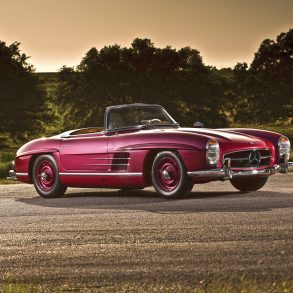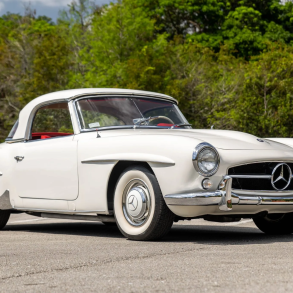The Dawn of the Modern Super Car
If you haven’t been behind the wheel of a brand new supercar recently, chances are you will find things have changed. Radically changed. Modern sports cars are loaded with astonishing technology. Highly refined drive mechanisms, computer controlled power delivery, sophisticated engine management, precision steering and gripping tire technology are but a few of the staggering innovations appearing annually, even on more modestly priced offerings. The basis of more recent changes can be traced back to the development of the microchip, software driven controls and precision metallurgy. But the biggest shift of all began with one car. A sports car so radically different and advanced that it would not only inspire sports cars for decades to come, it remains today one of the most sought after collectible classic cars.
The Mercedes-Benz 300SL Gullwing is one of only a few iconic vehicles that has sustained cultural, artistic and performance importance for over six decades. Originally released in 1954, with production culminating in 1957, just 1,400 of these world-class cars were produced and delivered to customers eager to own one of the finest road-going sports cars ever assembled for public use. The automotive press heralded the 300SL as a triumph of engineering and design. Delivered with production fuel-injection (the first of it’s kind), and achieving the world’s fastest top speed, the 300 SL (S-Sport, L-Light) confirmed Max Hoffman’s challenge to Mercedes-Benz engineer Rudolf Uhlenhaut— build a Grand Prix car tailored for road use. The 300 SL would not only become an iconic road car, it would further generate dozens of racing achievements, and wake up every automobile manufacturer to the new normal in vehicle excellence. Not surprisingly, the Gullwing spawned not only a new age of ultra-performance cars, it spawned a new age of ultra-performance designers and engineers seeking to up their automotive game to new standards of excellence.
The contemporary press could not find enough words of praise and wonderment to foist upon the Gullwing. Nearly everyone recognized the collective impact that Mercedes-Benz had achieved with this landmark automobile. It was not only inspirational in construction and design, it truly represented the sports car of the future – not a dream, but a production reality.
The first impression one has of the 300SL is that the entire car is instantly recognizable, both as a stunning work of art and an astonishing capsule of engineering. The cohesive elegance and performance were unprecedented at the time, and yet remain stunning today. Of course, the opened gullwing doors are the most visually arresting feature, but even when closed, there is a sense that something special awaits you when entering this vehicle. The doors were not devised for the sake of novelty, rather the sophisticated lightweight frame configuration simply wouldn’t allow for the use of conventional doors. There was no way to hinge a full door opening along the vertical side of the door line while retaining the structural integrity of the frame. So a half door opening was constructed, but here too, the roof and side glass had to be relieved in order to allow a full sized person entrance and exit. So particular was the geometry and convolutions for entrance, that the steering wheel had to be relieved of its upright position via a unique locking pivot mechanism. Getting into a 300SL, one is given such specialized instructions, and mechanical allowance, you feel as though you are entering an aircraft tailored for specialized missions. The doors were not only an innovative engineering achievement, they were also a proportional game changer for exterior car design and packaging. Sedan designs of the period were stodgy and upright, featuring tall, slab sides and vertical side glass. Sports cars were smaller versions of the same idea, and racecars were radically different. The 300SL sat at nearly half the height of a conventional sedan, with quite a bit of tumblehome, a very snug interior, dramatically curved glass, and racecar body design – evoking an aircraft cockpit rather than an automobile. The overall effect of these undulating curvilinear forms was further enhanced by the round fenders in the body design, accented by crisp speed streaks over the wheel openings and across the hood – design themes that several cars would adopt in the years to come.
Under the hood, the fuel-injected, overhead cam engine laid down at an angle, allowing for a low profile hood and small frontal cross section. Even the formerly upright Mercedes-Benz grille had to be discarded in favor of a new elongated horizontal opening, establishing a new design architecture that lingers in Mercedes-Benz sport models today, carrying over into sedans and even their SUV models.
One of the most exotic cars available when new, and brimming with innovative features, Gullwings were fast, beautiful, and exclusive. Their appeal continues to be timeless and consistently in demand, in part due to their inherent beauty but also their exceptional build quality. Beauty, timeless excellence, world-class engineering and stunning design, all captured in a singular vehicle – the grandfather of all modern super cars, the Mercedes-Benz 300SL Gullwing.













